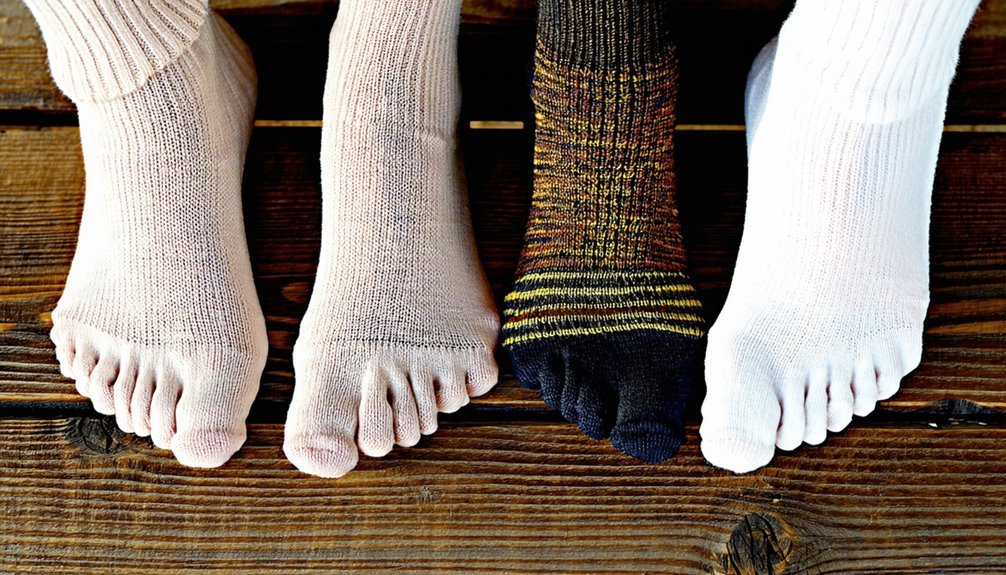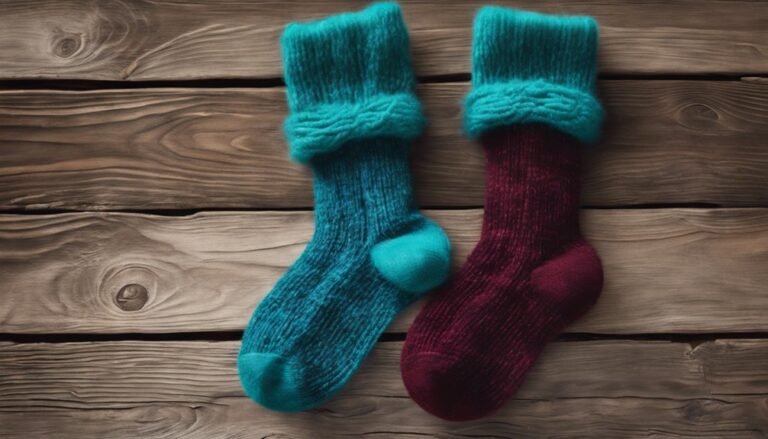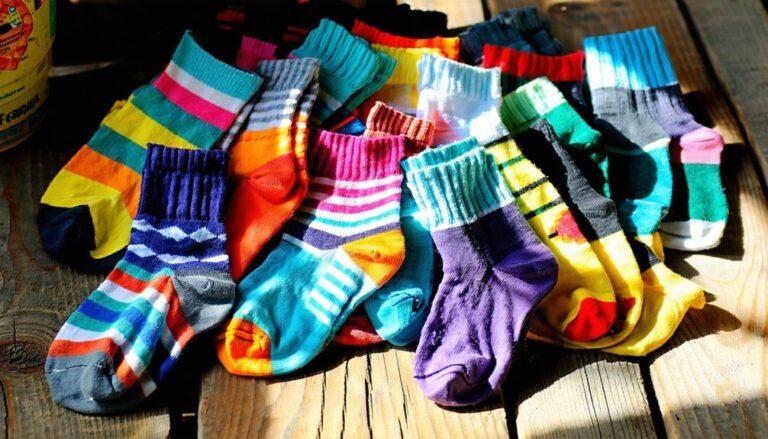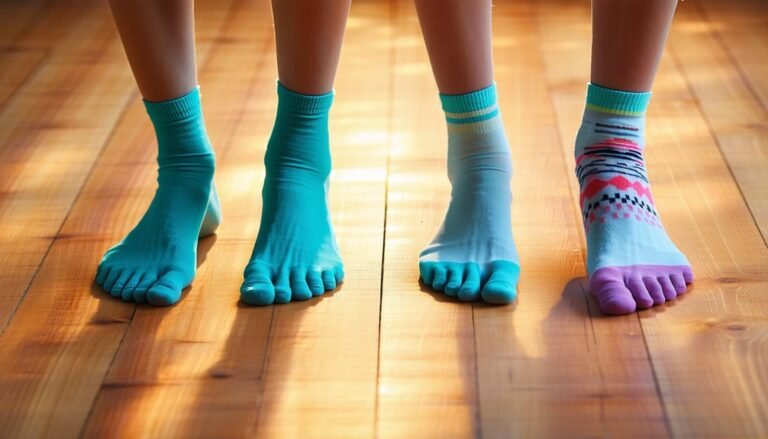Bamboo Vs Wool Socks
When choosing between bamboo and wool socks, each offers distinct advantages. Bamboo fibers provide excellent moisture-wicking and anti-bacterial properties, ensuring dry and odor-free feet. Wool's unique crimped structure excels in thermal regulation, offering superior warmth retention even when wet. Bamboo's biodegradable nature contrasts with wool's higher carbon footprint but shares durability. Your needs for comfort, moisture management, and environmental impact will guide an informed choice. To discover more nuances, explore further.
Understanding Bamboo Socks

Bamboo socks, a fascinating innovation in textile technology, offer unique properties due to their fiber composition. You'll find that the bamboo cellulose fibers are naturally smooth and round, reducing the potential for skin irritation. These fibers exhibit excellent moisture-wicking properties, ensuring your feet stay dry and comfortable. Additionally, bamboo's inherent antibacterial qualities provide an extra layer of protection, minimizing odor and promoting foot health.
From a sustainability perspective, bamboo properties shine. It's a rapidly renewable resource that doesn't require replanting after harvest, and it grows with minimal water usage and no pesticides. This sustainability aspect makes bamboo socks an eco-friendly choice, aligning with your safety and environmental consciousness. By choosing bamboo, you contribute to a healthier planet while prioritizing your personal well-being.
Exploring Wool Socks
When considering wool socks, you'll find that their thermal regulation and moisture-wicking properties arise from the unique crimp and scale structure of wool fibers. These natural attributes make wool an excellent insulator, retaining warmth even when wet, while also allowing for breathability. For ideal performance and longevity, it's essential to adhere to proper wool care techniques such as gentle washing and air drying to prevent fiber degradation.
Wool Socks Benefits
Wool, a natural fiber derived from sheep, offers unparalleled benefits in sock design due to its unique material properties. The crimped structure of wool fibers creates air pockets, enhancing thermal insulation, which is essential for maintaining ideal foot temperature in varying conditions. You'll find that wool socks provide superior warmth retention, vital for safety during cold weather exposure. Additionally, wool's inherent moisture-wicking capability promotes dryness, reducing the risk of blisters and other discomforts.
Odor resistance is another advantage. Wool fibers naturally inhibit the growth of odor-causing bacteria, ensuring your feet remain fresh throughout the day. This property is particularly beneficial for those engaging in prolonged activities or in confined environments. Embrace wool socks for their unparalleled combination of comfort, safety, and hygienic benefits.
Wool Care Tips
Having understood the myriad benefits that wool socks offer, it's important to guarantee their longevity and performance through proper care. Wool fibers possess unique scales that can interlock and felt if mishandled. To maintain their structural integrity, opt for gentle wool washing. Utilize cold water and a mild detergent explicitly designed for wool. Avoid harsh agitation that can cause fiber damage. When it comes to wool drying, never wring out excess water. Instead, gently press and reshape your socks while damp. Lay them flat on a towel, away from direct heat or sunlight, to preserve elasticity and prevent shrinkage. By adhering to these wool care principles, you'll ascertain your socks remain resilient, providing warmth and comfort safely over time.
Comfort and Feel

In evaluating the comfort and feel of bamboo versus wool socks, it's essential to take into account the intrinsic properties of each fiber. Bamboo fibers, known for their smooth, round surface, offer a soft texture, reducing friction against your skin and minimizing irritation. Wool fibers, on the other hand, possess a natural crimp, providing a cushioned feel that enhances thermal insulation. When considering breathability comparison, bamboo's micro-gaps allow better air circulation, keeping your feet cool and comfortable. Wool, while less breathable, excels in maintaining warmth, a significant safety feature in colder conditions. Texture differences become apparent as bamboo provides a silky, lightweight feel, whereas wool offers a robust, plush texture. Both fibers prioritize safety, ensuring comfort in varied environmental conditions.
Moisture Management
When it comes to moisture management, bamboo and wool socks exhibit distinct fiber characteristics that impact their performance. Bamboo fibers are known for their breathability, which facilitates air circulation and enhances moisture evaporation. This natural ventilation leads to superior sweat absorption, ensuring your feet remain dry and comfortable. Wool, on the other hand, features a unique crimped structure that traps air, providing excellent insulation and moisture-wicking properties. Its ability to absorb up to 30% of its weight in moisture without feeling damp makes wool socks a reliable choice for managing perspiration.
In a breathability comparison, bamboo generally offers better airflow, while wool excels in moisture retention and wicking. Both materials prioritize foot safety by reducing the potential for blisters and fungal infections through effective moisture management.
Environmental Impact
When evaluating the environmental impact of bamboo versus wool socks, you'll need to contemplate the resource consumption associated with each material. Bamboo cultivation requires considerably less water compared to wool production, yet raises concerns regarding chemical processing in fiber extraction. Additionally, while both materials exhibit biodegradable properties, the production emissions and energy inputs differ, with wool processing often resulting in higher greenhouse gas emissions.
Resource Consumption
Resource consumption plays a pivotal role in evaluating the environmental impact of bamboo and wool socks. When analyzing fiber sources, bamboo demonstrates higher resource efficiency due to its rapid growth rate and minimal water requirement. This makes it a prime candidate in sustainability assessments. Conversely, wool production demands significant land and water resources, posing a challenge regarding resource efficiency. The energy-intensive processes involved in wool fiber extraction further elevate its environmental footprint.
For safety-conscious consumers, understanding these dynamics guarantees informed choices. Bamboo's anti-bacterial properties add an additional layer of appeal, reducing the need for frequent washing, thereby conserving water. By examining the material properties and resource consumption patterns, you can align your sock choices with environmental priorities, guaranteeing safety for both you and the planet.
Biodegradability Concerns
In evaluating the ecological implications of bamboo and wool socks, examining biodegradability becomes crucial. You need to take into account how each material interacts with the environment post-use. Wool fibers, being natural protein-based structures, degrade efficiently under appropriate conditions, promoting sustainable practices. Bamboo, processed into viscose, is also regarded as a biodegradable material, though it requires specific conditions to break down completely.
| Material | Biodegradability | Decomposition Conditions |
|---|---|---|
| Wool | High | Natural environments |
| Bamboo | Moderate | Industrial composting |
| Nylon | Low | Non-biodegradable |
Understanding these properties guarantees you choose socks that minimize environmental impact. Wool offers a safer, naturally decomposable option, while bamboo's need for controlled decomposition settings means it's crucial to guarantee appropriate disposal practices. Prioritizing biodegradable materials is imperative for a greener future.
Production Emissions
Although both bamboo and wool socks offer environmental benefits, their production processes yield differing levels of emissions. When you examine bamboo socks, the primary emission sources stem from processing raw bamboo into viscose fibers. This involves chemical treatments that can release harmful substances if not managed properly, impacting air and water safety. Conversely, wool socks involve emissions from livestock farming, particularly methane from sheep, and energy-intensive cleaning and spinning operations. Wool's production processes require significant water and energy inputs, contributing to higher carbon emissions overall.
To mitigate these environmental impacts, it's essential to prioritize sustainable practices. Opt for bamboo processed via closed-loop systems or wool sourced from farms adhering to eco-friendly standards. Understanding these emission sources helps you make informed, safe choices for the environment.
Choosing the Right Sock for You
When determining the ideal sock for your needs, how do bamboo and wool compare with respect to fiber composition and material properties? Bamboo fibers offer high sock durability due to their robust tensile strength, ensuring longevity through extended wear. Their natural thermal regulation properties provide a comfortable microclimate, ideal for both hot and cold conditions. Wool fibers, renowned for their insulating capabilities, offer excellent thermal regulation by trapping air within their crimped structure, providing warmth and moisture-wicking properties.
For individuals prioritizing safety and comfort, consider bamboo socks if you require enhanced durability and versatility across various climates. Conversely, wool socks are best for colder environments where thermal retention is paramount. Ultimately, understanding the distinct characteristics of these materials will guide you to the right choice.
Frequently Asked Questions
Do Bamboo or Wool Socks Have Better Odor Resistance?
You're wondering about odor resistance. Bamboo socks boast natural antibacterial properties, offering excellent odor control. Wool socks, however, have inherent moisture-wicking abilities, reducing bacterial growth. Both fibers excel, but bamboo socks might slightly edge out in odor resistance.
Are Bamboo Socks Suitable for People With Allergies?
Imagine bamboo benefits wrapping your feet like a gentle embrace. You'd find bamboo fibers smooth and hypoallergenic, reducing irritation. For allergy considerations, they're generally safe, but always check for specific sensitivities to guarantee comfort and safety.
How Do Bamboo Socks Compare in Durability to Wool Socks?
When considering durability, bamboo fibers offer impressive breathability and moisture-wicking, but wool strength delivers superior resilience and elasticity. If safety's your priority, wool's natural flame resistance and insulation provide a reliable barrier in various conditions.
Can Wool Socks Be Machine-Washed Without Damage?
Yes, wool socks can be machine-washed safely with proper fabric care. Use a gentle cycle with cold water and mild detergent. Avoid high heat; it's essential for preserving fiber integrity and preventing material degradation. Follow these washing tips.
Which Material Is More Effective for Temperature Regulation?
You're considering temperature regulation, so evaluate breathability comparison and moisture management. Analyze fiber properties: wool excels in moisture-wicking and insulation, while bamboo offers superior breathability. Both materials prioritize safety through natural temperature control mechanisms, ensuring comfort and protection.







